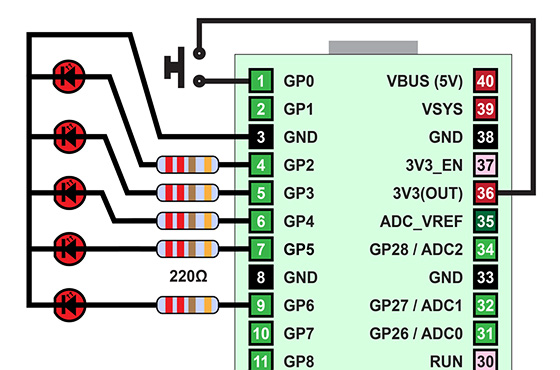

Since it is an M0 chip, it does not have a floating point unit, or DSP hardware support - so if you’re doing something with heavy floating point math, it will be done in software and thus not as fast as an M4. The RP2040 is a powerful chip, which has the clock speed of our M4 (SAMD51), and two cores that are equivalent to our M0 (SAMD21). Just note you don’t double-click reset, instead hold down BOOTSEL during boot to enter the bootloader!

Folks who have been using Adafruit products will find this very familiar - we use the technique all our native-USB boards. What that means is when you want to program new firmware, you can hold down the BOOTSEL button while plugging it into USB (or pulling down the RUN/Reset pin to ground) and it will appear as a USB disk drive you can drag the firmware onto. Inside the RP2040 is a ‘permanent ROM’ USB UF2 bootloader. On the slim green board is minimal circuitry to get you going: A 5V to 3.3V power supply converter, single green LED on GP25, boot select button, RP2040 chip with dual-core Cortex M0, 2 MegaBytes of QSPI flash storage, and crystal. There are no true analog output (DAC) pins. All of the GPIO pins are 3.3V logic, and are not 5V-safe so stick to 3V! You get a total of 26 GPIO pins, 3 of those can be analog inputs (the chip has 4 ADC but one is not broken out). There’s 20 pads on each side, with groups of general purpose input-and-output (GPIO) pins interleaved with plenty of ground pins. The Pico is 0.825” x 2” and can have headers soldered in for use in a breadboard or perfboard, or can be soldered directly onto a PCB with the castellated pads. This low-cost microcontroller board features a powerful new chip, the RP2040, and all the fixin’s to get started with embedded electronics projects at a stress-free price. The Raspberry Pi foundation changed single-board computing when they released the Raspberry Pi computer, now they’re ready to do the same for microcontrollers with the release of the brand new Raspberry Pi Pico.


 0 kommentar(er)
0 kommentar(er)
